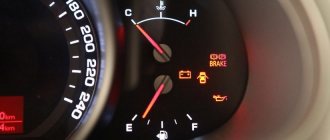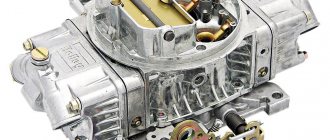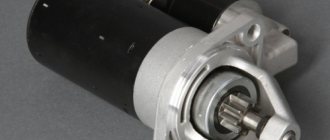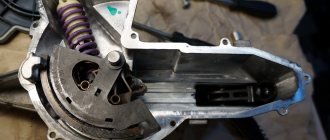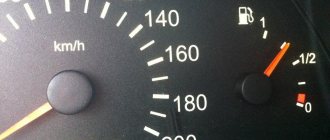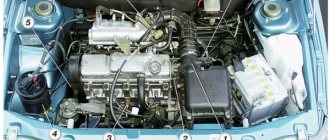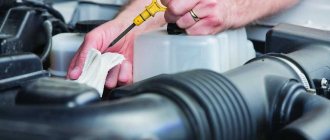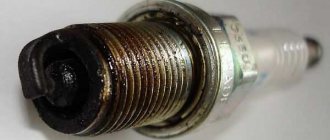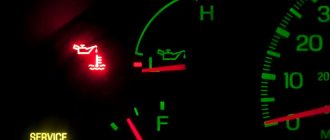18.10.2019
| (Votes: 2, Rating: 4) |
Issues discussed in the material:
- How does the coolant temperature light work?
- Why is the coolant sensor so important?
- Why might this indicator light up?
- What to do if the engine coolant temperature light comes on
From year to year, there is a trend of increasing complexity of the automobile instrument panel. This is expressed mainly in the fact that it displays a huge number of icons informing the driver about the status of certain vehicle systems.
If we talk about the coolant icon, it is not one of the new ones, since drivers have been able to control cooling indicators for quite a long time. However, sometimes many people do not understand why the temperature light is on. Our article will talk about what can happen if you do not pay attention to this signal, and how to act in cases where it lights up.
Here's what to do if your engine temperature rises.
Although at first glance an increase in engine temperature seems like a normal and simple problem, it can lead to overheating of the engine and can also lead to serious problems with the engine. If your car overheats, you could damage the engine if the necessary measures are not taken.
The first sign of a car overheating is a sharp rise in temperature at the coolant temperature sensor, which is located on the dashboard.
Also, if you notice steam coming from under the hood, this is a clear sign that the coolant has boiled, which indicates that the engine has exceeded operating temperature. See also Just about the operation and main components of the car engine cooling system.
What to do in this case? Why do cars overheat? How to solve a problem? We will tell you about this in detail.
Attention! The information is provided as a guide only and to help you understand what engine overheating is. If you are faced with an increase in engine temperature, it is best, of course, to consult with a specialist who will conduct a thorough diagnosis and determine the cause of the car overheating, and also offer you to eliminate it.
Purpose of VAZ 2114 devices and interpretation of the symbols on them
Located on the left side of the dashboard, directly in front of the driver's seat, the VAZ 2114 instrument cluster plays an important role in driving. It contains pointer instruments, VAZ 2114 indicators with electronic digital windows and signal lights for various purposes.
- An induction speedometer, which receives speed readings from a sensor located directly in the gearbox, shows the actual speed of the car from zero to two hundred kilometers per hour. The division price is 10 km/h. It must be borne in mind that such devices have a permissible error of at least 5 km/h. In the lower, central part of the device there is a window with an electronic display, in which two lines reflect the total mileage for the entire period of operation of the car and the current mileage.
- To the left of the speedometer is the tachometer. This is an electronic device that, receiving a signal from the on-board computer, shows the current crankshaft speed at that particular moment. The scale has divisions of 5 units, digitization is done after 10 units, the maximum value is 80. When multiplied by 100, the real number of revolutions is obtained, for example, 30 multiplied by 100, the result is 3000 rpm. The range of 55 - 60 is shaded in red - this signals that the critical speed is approaching. The critical range 60 - 80 is shaded in red. If the speed increases to these values, the engine may fail. In the lower middle part of the device, an electronic display displays the time and real ambient temperature.
- To the left of the tachometer there is a dial gauge for the coolant temperature. It receives a signal about the actual condition from the coolant temperature sensor, which is located between the cylinder head and the thermostat. The division value is 20 degrees. Digitization of the device begins at 50, after two divisions it is 90 and the divisions end at 130 degrees. The red, danger zone starts at 105 degrees. If the arrow falls into this zone, then the engine must be turned off immediately, no matter what mode it is operating in. Due to overheating of the engine, failure of the main blocks of the power unit is possible. At the top, near the number 130, there is a graphic temperature icon. To the right of the speedometer is a device indicating the presence and level of fuel in the car’s fuel tank.
How can you tell if your car is overheated?
You can see if the car is overheating by looking at the coolant temperature gauge we marked in the photo above. This temperature sensor is located on the dashboard. The sensor pointer should not exceed 90-95 degrees, that is, go far beyond half the values. If the temperature gauge is above 90-95 degrees, your engine has a cooling problem and may overheat at any time.
Why does the car overheat, what are the reasons?
There are two most common causes of engine overheating:
- Low coolant level (it is also possible that the antifreeze has lost its properties)
- Cooling fan malfunction
In addition to this, the car may have problems with the engine temperature sensor, with the thermostat, which can cause the engine temperature to rise. In particular, the engine may exceed operating temperature due to a driver who drove for a long time at maximum engine speed or incorrectly shifted the manual transmission.
Below we will explain these reasons in more detail.
What to do if the engine overheats?
It all depends on how overheated the engine is. If the coolant temperature briefly and slightly exceeds 90-95 degrees, then park the car in a safe place and turn off the engine. It is advisable to place the car in the shade or any cool place, hiding it from direct sunlight. Open the hood and wait. When the engine has cooled, check the coolant level. Be careful as the antifreeze in the cooling system is under pressure.
See also How long should you warm up your car engine before you can drive at high speeds? Expert answers
Due to its properties, coolant does not cool quickly. So, when opening the radiator or expansion tank cap, be careful not to let hot antifreeze get on your body under pressure. After checking the antifreeze level, add it if necessary to the required level. If you do not have antifreeze with you, you can add distilled water as an emergency measure (if, of course, we are talking about the summer season). If the coolant level is normal, but the engine temperature is constantly rising (especially when the car is stationary), then contact a mechanic immediately.
If the coolant temperature has reached the red zone and the car has essentially boiled, you should also urgently park the car on the side of the road. True, in this case you do not need to look for a cool place, since you simply do not have time for this, unless, of course, you want to ruin the engine.
Also, after parking the car, do not turn off the engine under any circumstances, as a sudden temperature change can damage the engine. To stop a further rise in temperature and boiling of antifreeze, turn on the stove to the maximum temperature, setting the airflow to the maximum level. This way you will ensure good heat removal from the coolant. Next, wait until the engine temperature drops before turning off the engine.
Your temperature indicator lights up
This light comes on when you turn on the ignition. This is fine. But a few seconds after the engine starts running, it should go out. If it continues to light, the coolant level in the cooling system is too low or there is a malfunction in the system itself. It happens that the indicator lights up directly while driving. This again may be a consequence of a lack of antifreeze. Another option is that the cooling system can no longer cope with the increase in the temperature of the unit.
It is worth noting that the color indication of different brands of cars may vary greatly. For example, blue indicates a low engine temperature, and red indicates a high temperature. You can learn about these subtleties from the operating instructions for a particular car.
What happens if you continue driving when the car is overheated?
When the engine overheats, the coolant boils and hot steam starts coming out from under the hood. True, in new cars that have a more sealed engine compartment, such steam can be noticed already when the engine is very overheated. If you ignore the boiling of antifreeze and the increase in the value on the temperature sensor, you risk that the engine in your car will fail - to the point that a piston or several pistons may seize. By the way, this is fraught not only for the engine, but also for you. Can you imagine the danger you expose yourself to while driving if the engine seizes?
Please note that not only pistons, but also many engine parts can fail. Including the block head and its components.
That's why as soon as you notice an increase in engine temperature, you should urgently stop your car and check the antifreeze level or a possible leak. You should also seek professional help if necessary.
What are the causes of overheating caused by a radiator?
Another common problem with engine overheating is a clogged radiator. In this case, the antifreeze that passes through the radiator is not properly cooled by the air while the car is moving. That is why, before each start of the summer season, it is recommended to clean the radiator from dust, dirt, dry leaves, etc. If this is not done, your car may boil on the first hot day.
Engine overheating due to pump
The coolant in the car is circulated by a water pump. Unfortunately, this part in a car does not last forever and can unexpectedly fail at the most inopportune moment. In this case, as soon as the water pump stops, antifreeze stops circulating through the cooling system, resulting in the normal heat exchange between the engine and the coolant stopping. In this situation, an increase in engine temperature is inevitable, even if other cooling systems are working normally.
Fire!
The main experiment is so simple that anyone can repeat our experiments. This includes manufacturers who have doubts about the results of ZR experiments: check whether your products burn or not.
Coolant becomes flammable when the manufacturer uses cheaper glycerin and methanol instead of expensive ethylene glycol. After all, the boiling point of methanol is only 64 degrees (normal coolant boils at a temperature of approximately 108 ºС). And this is dangerous not only because such antifreeze can flare up, accidentally landing, for example, on a hot collector.
A horror story for those who believe fairy tales about the harmlessness of coolants with methanols and glycerols. In its former life it was a high-quality cast iron sleeve. But she lost the fight against cavitation by knockout. Along with the engine, of course.
Let's take a look inside the engine. The pistons move up and down, the crankshaft rotates. Such “gymnastics” inevitably causes vibrations in the cylinder walls: the liners begin to vibrate. The coolant experiences pressure changes, periodically boiling. In this case, air bubbles appear on the outer walls of the liners, which, when bursting, give rise to the effect of cavitation. And if the liquid is low-boiling (with glycerin and methanol), cavitation increases sharply. The bubbles explode, gnawing pieces of metal from the cartridges. After that, there are two options: major repairs or trash. Similarly, the coolant pump impeller suffers from cavitation.
In addition, if vapor locks occur in the cooling system, the coolant stops circulating. The engine begins to overheat, the methanol from the coolant boils away, leaving an aqueous solution of glycerol with a crystallization temperature of -20 to -12 ºС. And such “antifreeze” may well freeze.
My car has a lot of antifreeze, but it gets hot. Is this a thermostat fault? How to solve this?
In a car, as a rule, there are two coolant circulation circles - small and large, which provide the car with both engine cooling, if necessary, and heating it. The circulation of antifreeze in these circuits is ensured by a thermostat.
When the engine is cold, the coolant (antifreeze) is also cold. In this case, the thermostat is in the closed position . In this case, the antifreeze circulates in a so-called small circle, in which the liquid does not pass through the radiator, but only through the engine. As a result, when the thermostat is closed, the coolant does not cool the power unit, but, gradually heating up from the heat of the engine, helps it quickly reach operating temperature.
After the antifreeze heats up to a certain temperature, the thermostat automatically opens and the liquid begins to circulate in a large circle into which the cooling radiator enters. Due to air flows while the car is moving, the liquid begins to cool, which helps cool the engine. Each thermostat is calibrated to open at a specific temperature.
Unfortunately, the thermostat can jam both on a small circle of coolant circulation and on a large one. This will determine how the running engine will behave: take a long time to warm up or quickly heat up/overheat.
Thermostat failure is a very common problem. A thermostat malfunction is especially dangerous in the summer, as it can lead to engine overheating. By the way, thermostat failure in winter (when it is stuck in the open position) is also fraught with problems. The fact is that due to a malfunction of the thermostat, the engine will take too long to warm up in winter, resulting in accelerated wear of its internal components. Also in this case, fuel consumption increases significantly.
Which icons on the dashboard mean you need to stop quickly.
We all know that cars have become smarter and more technologically sophisticated. So, a lot of strange icons and inscriptions appeared on the dashboard. Many of them mean that something has happened to your car. Meanwhile, most motorists simply ignore various warning signs on the dashboard. But in vain, as this often leads to expensive repairs. Here are three of the most dangerous dashboard warnings that signal you need to stop immediately.
Many car owners, of course, know about the most famous “CHECK ENGINE” icon, which warns of engine problems. Naturally, many drivers believe that this is the most important indicator on the dashboard.
Moreover, because of this, some motorists believe that all other warnings on the dashboard are not so important. But that's not true. The fact is that the "Check Engine" light may come on and not because of major problems that do not require an immediate stop. Moreover, usually, when CHECK ENGINE lights up on the dashboard, the engine control unit switches it to emergency mode, which prevents damage to the power unit if problems arise.
Unfortunately, car enthusiasts forget that in addition to the “Check Engine” indication, there are also a lot of different warnings, when they appear, you need to stop as soon as possible.
For example, we recently talked with a motor mechanic working in a large technical center, who told us an instructive story about one car owner where an expensive engine failed. And do you know who is to blame? The owner himself, who, having seen the burning oil can icon on the dashboard, thought that this was a reminder of the scheduled engine oil change. As a result, having ignored the system warning about low oil pressure, the car owner personally “killed” the rather old engine.
So never ignore any warning message or illuminated icon on your dashboard. Also, you should not guess the purpose of a particular symbol or decipher the meaning of the inscription that appears. You need to know exactly what this or that symbol on the dashboard means. If you don’t know, learn the equipment by referring to the car’s operating manual or looking for information on the Internet. Such “guessing” of symbols on the device can be even worse than simply ignoring warnings. After all, not knowing the purpose of the icons on the dashboard is about the same as trying to fix a problem without knowing how to do it.
What happens if the cooling fan fails?
The most important parts of an engine cooling system are the fans, which cool the engine when antifreeze cannot handle it. Typically, two fans are used in the engine compartment: one runs almost always, while the other is activated at certain engine temperatures. Some cars use one fan. Typically, a cooling fan helps cool the engine when the car is moving at slow speeds or is stationary (when there is not enough air flow to cool the antifreeze in the radiator).
See also Cylinder head gasket defects, causes, consequences and how to avoid them
Unfortunately, if your machine uses two fans, if one fan fails, the engine will not cool enough in certain situations. That is why, if the engine overheats when the antifreeze level is normal, in addition to the thermostat, you must first check the cooling fan. We also recommend that you check the performance of the cooling fans before the start of the summer season, so as not to encounter engine cooling problems in a summer traffic jam.
Antifreeze is leaking somewhere in my car! Why does the coolant level drop?
Under normal conditions, the engine cannot be a source of coolant consumption, which circulates in the cooling system in a closed closed circuit. However, if one of the cooling system pipes is damaged or if the clamps holding them are loosened, antifreeze may leak. In this case, even if you add coolant, it will still leak if you do not solve the problem, which can lead to engine overheating and other consequences. As a solution, you need to contact a car service center, where they will find the cause of the antifreeze leak and fix the problem.
Also note that a coolant leak can be in the cooling radiator, in the heater radiator (usually in this case, antifreeze will accumulate in the passenger compartment under the mats), if the expansion tank is damaged, if the water pump is defective, as well as if the engine is damaged (crack in engine block, etc.).
By the way, most often an antifreeze leak can be easily detected by carefully inspecting the engine compartment, as well as the space under the car.
“About one difference between G-11 and G-12++ class antifreezes”
AGA antifreezes are made on the basis of an aqueous solution of the highest grade monoethylene glycol with a hybrid additive complex, including organic and inorganic compounds. The AGA antifreeze additive package is constantly being improved to improve the suppression of foam, corrosion and cavitation erosion in the cooling systems of any piston engine - from small passenger cars to high-power truck tractors and heavy commercial equipment. None of the AGA antifreezes contain esters, phosphates or sealing additives, cheap replacement components such as methanol and glycerin. Accordingly, AGA antifreezes do not burn, unlike many coolants present on the Russian market today.
It is noteworthy that antifreezes AGA-Z40, AGA-Z42, AGA-Z65, corresponding to the G-12++ level (according to VW classification), use inorganic components such as stabilized silicates, which provide increased protection of aluminum from corrosion, and rubber elements from cracking, loss of elasticity and deformation. This increases the service life of the cooling system and increases its reliability, eliminating sudden loss of antifreeze due to rupture of rubber hoses and pipes.
It should be emphasized that the use of stabilized silicates defines AGA antifreezes as lobrid (G-12++), so they should not be confused with classic (traditional) silicate antifreezes G-11. Stabilized silicates and simply silicates are completely different things. However, it is precisely the highest protective ability of conventional silicates in relation to aluminum and rubber-containing elements of the cooling system that forced the creation of a new variation for modern antifreezes (stabilized silicates).
The fact is that in the process of many years of practice it turned out that “pure” organic antifreezes G-12 (silicate-free), even those meeting the ASTM D6210 standard, do not provide sufficient protection of elastomers (gaskets, hoses, pipes) from deformation and formation cracks under severe operating conditions. This problem is reflected in sufficient detail, for example, in the CUMMINS Service Bulletin 4960814-04 regulations. Therefore, due to the outstanding characteristics of classic silicates, the AGA assortment includes antifreeze AGA-L40 category G-11, which successfully finds its buyer due to its fairly high quality and lower price.
